Congratulations, you’ve done the hard part: setting up a knowledge base on your website.
Now, your customers are empowered to self-serve and find answers to their questions using this valuable resource.
This should lead to fewer repetitive calls and inquiries for your customer support team, boosting overall productivity.
But hold on a moment.
Have your knowledge base articles been reviewed for accuracy and clarity? How should you approach creating and organizing your knowledge base content? What best practices should you follow to ensure your articles are genuinely helpful? And perhaps most importantly, can you consider downsizing your customer service team now that you have these efficient self-service options in place?
Below, we’ll cover:
- The thing most businesses get wrong about knowledge base articles
- How to write an effective knowledge base article in 7 steps
- 3 knowledge base article templates (with examples)
💚Are you using AI to improve your customer experience? Learn how in our new eBook.
First, let’s define what we mean by a “knowledge base article.”
What do most businesses get wrong about knowledge base articles?
A knowledge base is an online library of articles and resources designed to help your customers get the most out of your products and services. Simple enough.
But even though this can be a great cost-effective initiative, many businesses tend to expect too much of their repository of knowledge base articles. Your knowledge base isn’t a replacement for providing good customer service—but it is a potent complement to your support team.
Even if you’re not investing in fancy automated customer service, you have to have the bare minimum: someone (or some people) on your team dedicated to customer service. (And if you do most of your business online, they should probably focus on online customer service.)
If you do have a customer service team, make sure they’ve got the tools they need to do a good job—namely some kind of contact center solution.
Now, let’s look at another way that businesses ask too much of their knowledge base articles. You shouldn’t have a knowledge base article for every single type of customer question you get. Knowledge base articles are great for two specific types of questions:
- Simple questions – These are the kinds of straightforward questions that can be easily explained in a few sentences and maybe a screenshot or two.
- For example: How to set up your new home thermostat in 3 easy steps
- Repetitive questions – These are questions that you get a lot. Instead of repeating yourself over and over, why not just have a page on your website where your customers can find the answer instead of clogging up your phone lines and inbox?
- For example: What are your weekend hours? (Although here we’d argue that a knowledge base article probably isn’t the answer either—this should be on your homepage and social media profiles)
For more complicated questions that are rare cases or are specific to the customer’s situation, a knowledge base article probably is not the answer. In these cases, you’ll need to have an actual human. Ideally, someone who isn’t already under a ton of pressure and distressed from juggling a Facebook Messenger conversation and Twitter DMs with five tabs open while taking a call. If this sounds like you, you might need an omnichannel contact center.
The goal of a knowledge base article is to solve the customer’s problem as quickly and as straightforwardly as possible. You don’t want people to have to keep searching on your website or Google after landing on your article just to piece together a complete answer. That’s why, unlike blog posts, it’s generally okay for a knowledge base article to have a high bounce rate: a customer finds the article, solves their problem, and then gets on with their day.
How to write an effective knowledge base article in 7 steps
What can you do to consistently write knowledge base articles that make it easy for customers to find the information they need?
Well, you need a writing process that takes into account the reader’s frame of mind and makes every effort to make sure the reading experience itself is engaging and comfortable.
It all starts with a little organization…
1. Plan your article
Creating an effective knowledge base article takes some planning.
You want to make sure that each article addresses a real customer issue and that the information is presented in a logical way.
You should refer to your knowledge base content plan when selecting the topic for your article. Make sure that you only have one article per specific topic—you don’t want to confuse people or by splitting things into multiple articles dedicated to the same subject matter.
Once you’ve selected a topic, jot down your main thoughts in bullet points to begin building an article outline. It’s a good idea to take a look at your old support tickets and talk with your support team to identify any pain points or customer questions that commonly crop up around that topic. The more of these issues you can check off in the article, the better.
The next step is to arrange your notes into a structure that reflects the customer’s process as they’re using your product or service. For example, if your instructions have to be carried out in a certain order, make sure your information is laid out chronologically. If the instructions don’t have to be carried out in any specific sequence, it’s best to place the easier steps at the beginning and move onto more difficult tasks as the article progresses.
When you’re happy with your outline, give it one final check to make sure the flow of information makes sense and that you haven’t left anything out.
2. Create your title
Your customers will find your article either by searching for a specific keyword or by browsing through a list of topics in your knowledge base.
So, it’s crucial that you create a title that clearly states what problem or task the article deals with. The title should be simple and to the point—there’s no need to craft anything eye-catching.
3. Get writing
Next up, writing.
The key here is clarity and precision. The top priority for whoever writes the article—whether it’s you, another support agent, or a technical writer—is to make sure that readers can easily understand the content.
Of course, the outline you’ve prepared will make sure your article has a natural progression to it, but you’ll also need to mind your writing style—no jargon or overly technical terms—to make sure your readers can easily understand the information they need.
Make no assumptions:
Don’t assume your readers have any familiarity with your product (unless, say, the article is explicitly directed toward “advanced” users). What may seem self-evident to you as someone who knows the product inside-out may be a source of confusion for the reader.
Put yourself in a beginner’s shoes and make sure you mention even the smallest details when laying out your instructions.
Whenever you mention something that could raise doubt in the mind of the reader, give an example to clarify what you mean. So, if the goal of your article is to explain how a certain feature works, first describe what it is and what it does, then bring it to life with an example or two.
The key takeaway here: leave nothing to guesswork.
Avoid jargon:
Another way to be clearer is to stick to well-understood words and phrases.
If you do have to use any technical terms, make sure you define them clearly in the text or point to a glossary where readers can look up what they mean.
It’s also good practice to use the same language your customers use to talk about a particular concept or feature. You can find out how readers refer to the topic in question by checking your support tickets and looking up what people search in Google.
Here are some extra tips to help make your writing more effective:
- Go step-by-step: Writing your instructions with one point per step will make your article much easier to follow.
- Don’t sell: Your support article isn’t there to persuade your customers to buy new products or pay for more upgrades. Its sole purpose is to help customers solve their product-related problems.
- Watch your tone: Similarly, your support articles aren’t the best place to offer opinions and analyses—save all that good stuff for your blog. Keep your tone professional and friendly, and adjust it as necessary to reflect the reader’s mindset. For example, if the article is about a recurring difficulty, you could acknowledge the frustration in your introduction and reassure the reader that by following the steps laid out in the article, they’ll solve the issue for good.
4. Format for readability
Don’t put off your readers by placing a dense wall of text in front of them.
Clear formatting will make your article easier to digest and will allow readers to quickly find the information they need.
These tips will help make your content more accessible:
- Break the article into short paragraphs and organize them under different headings and subheadings.
- Include a table of contents with anchor links so that users can jump straight to whichever section is most relevant to them. This is especially useful for longer articles.
- Draw the reader’s attention to key pieces of information or action items by using bold, italicized, or highlighted text.
- Use numbered lists, bullet points, and tables to parcel related or sequential information.
- Make sure any asides or notes are clearly differentiated from the rest of the text.
5. Linking
Ideally, customers who land on your article will find all the information they need on that one page.
But in cases where a customer wants to learn more about a related topic or feature, or when your article only covers one aspect of a larger set of tasks, it’s important to give readers links to other relevant pages. For example, a customer might want to learn about RingCentral’s video call solutions. In which case, use a link as shown, rather than explaining where a link is, or suggesting a reader ‘click here’.
The trick is to use links strategically—you don’t want to break the flow of the article by distracting the reader with links in every other word.
At the bottom of your article, it’s a good idea to include a “related articles” or “further reading” section. This will often draw the customer’s attention to problems they didn’t know they had (and reinforce your reputation for providing useful, proactive customer support.)
6. Add visuals
No matter how clearly you format and write your support article, it can be very hard for readers to understand the information without visual aids.
Sometimes, it’s better to show than tell.
Screenshots and videos are especially helpful in the context of a knowledge base article.
Screenshots:
Screenshots come in handy when explaining instructions with multiple steps. Instead of having to explain each part of the process in words, screenshots fill in the gaps and make it easy for the reader to follow along. Here’s a great example from Asana (you can’t see it here but it’s actually a GIF):
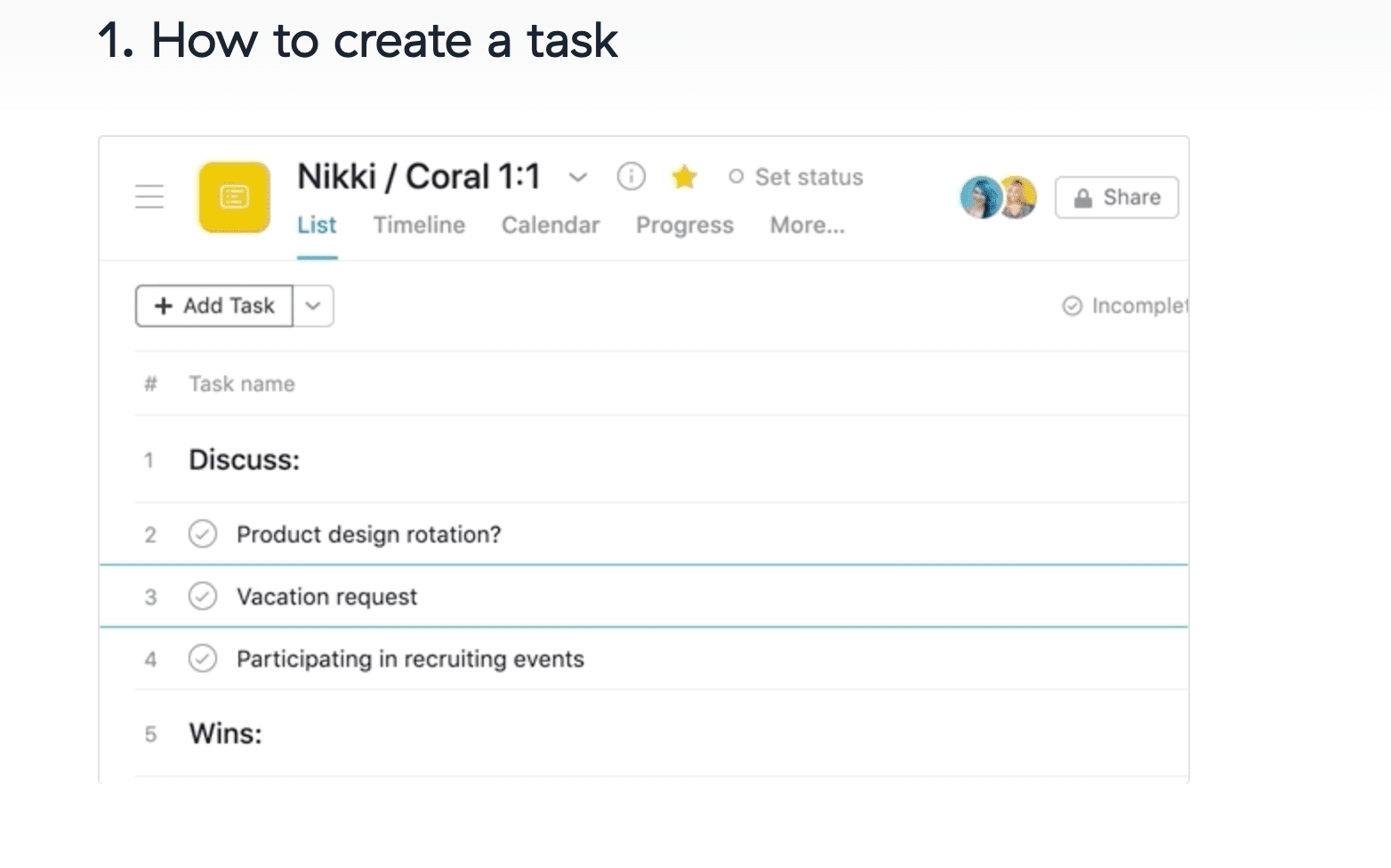
One way to improve the clarity of your screenshots is to annotate them with numbers, arrows, and circles. This lets you draw the reader’s attention to a specific area of interest.
It’s also good practice to place the screenshot after the instruction it’s used to illustrate, to avoid confusion.
Videos:
Videos are well-suited for tutorials and product demos. They work less well when people are looking for quick solutions because they tend to want to jump straight to the piece of information they need.
It’s best to place your video at the start of the article or at the top of a new section. Placing it in the middle of the text risks breaking the flow of the article.
It’s also a good idea to add a transcript to your video for customers who are hard of hearing or just prefer no sound.
7. Review
Before you go ahead and publish your new knowledge base article, you’ll need to review it for any spelling or grammatical errors.
You should also double-check that all the technical information within the article is accurate and up to date. One way to do this is to run the completed draft past a subject matter expert within your company.
Inaccurate information and obvious mistakes will only frustrate customers and diminish their trust in your knowledge base.
3 knowledge base article templates (with examples)
One of the best ways to streamline the production of your support articles is to use a standardized set of templates. This will save time for your writers and will ensure that all your articles have a consistent feel and structure throughout the knowledge base.
You’ll need a different template depending on the type of article you’re creating. Most knowledge bases will consist of one or more of the following article types: FAQ pages, how-to guides, troubleshooting articles, and general product documentation.
Here are three template examples to help you on your way:
1. How-to article
How-to articles teach customers how to perform a certain task or use a specific product feature by breaking down the procedure into step-by-step instructions.
Here’s an example of a how-to article from Dropbox:1
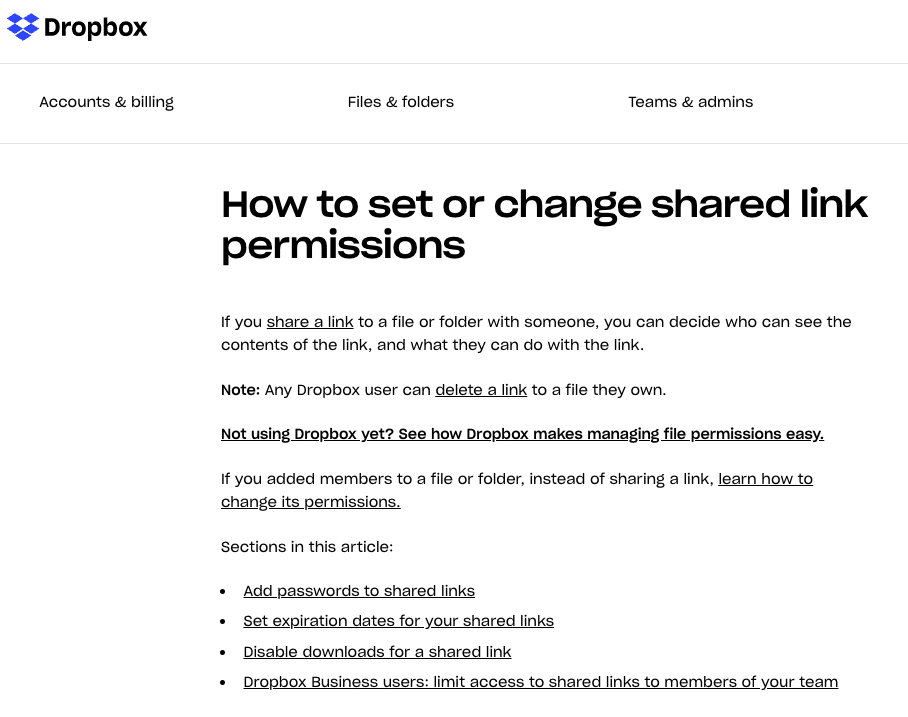
The article begins by giving a brief description of the feature being covered. It also distinguishes this feature (setting link-sharing permissions) from a related, but separate, feature (managing link-sharing permissions). This makes sure that readers are on the right page from the outset.
The different article sections are also listed in a table of contents. This gives readers an immediate idea of what the article is about and gives them the option to skip ahead to the section that interests them most.
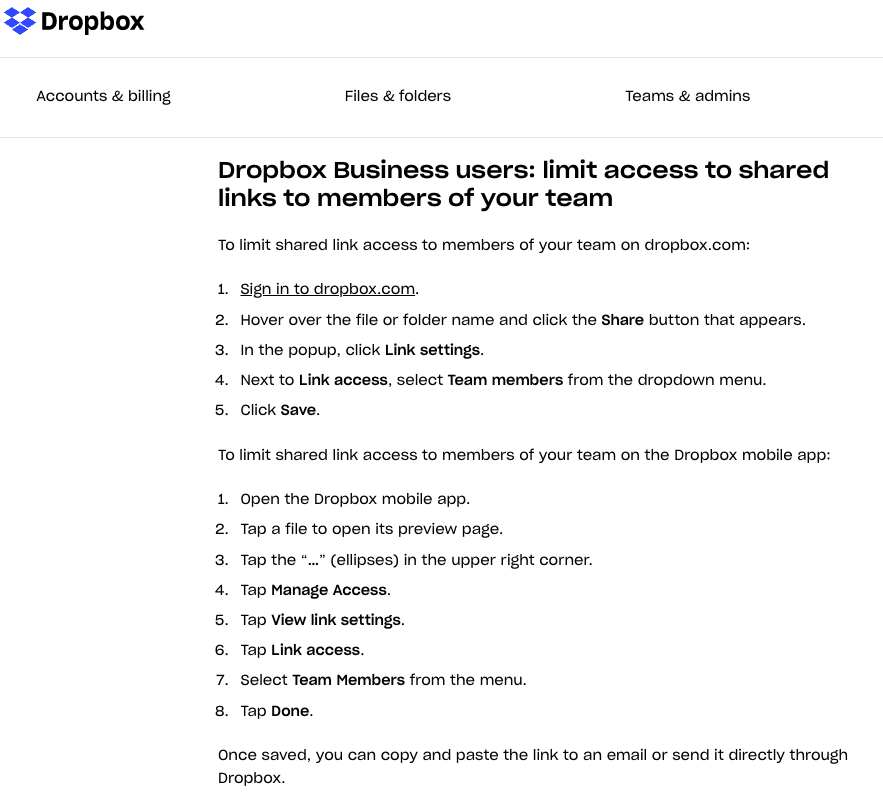
Here we see how the instructions are laid out within each section. The structure is simple enough: a description of the task, then a series of actions for the user to take, followed by a description of the outcome.
How to article template
Title: How to [task name]
Task: Brief description of the task to be completed
Prerequisites (if applicable): Brief description of which products/features/customers the task does/doesn’t apply to
Table of contents (if necessary)
Instructions:
- Step 1
- Step 2
- Step 3
- Etc.
Outcome: Brief description of what should be possible once the task is completed
Further reading: Links to related articles
2. Troubleshooting article
Though quite similar to how-to articles, troubleshooting articles focus on providing solutions when things go wrong, as opposed to teaching customers how to get the most out of a particular feature.
Here’s an example from Asana about how to troubleshoot connectivity issues:2
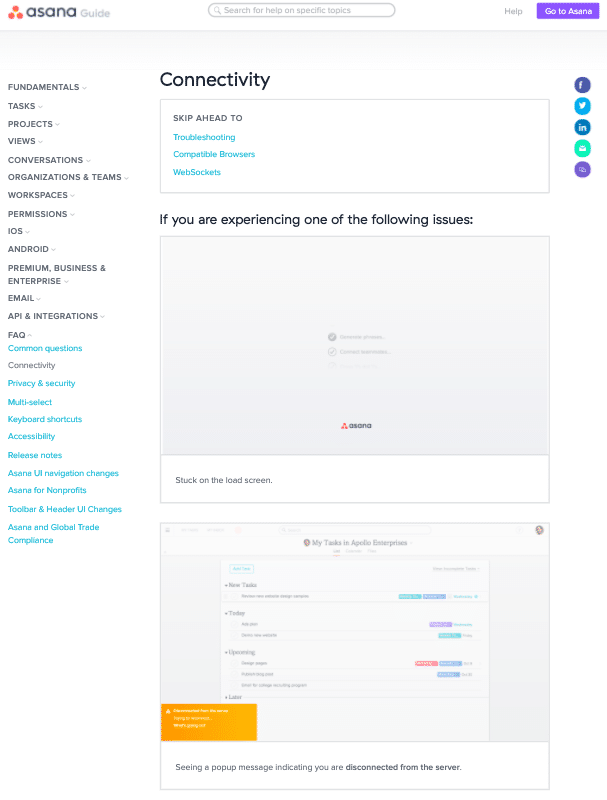
The introduction jumps straight into listing the types of problems the article will help solve, listing the different error messages the customer is likely to have encountered before looking for a solution.
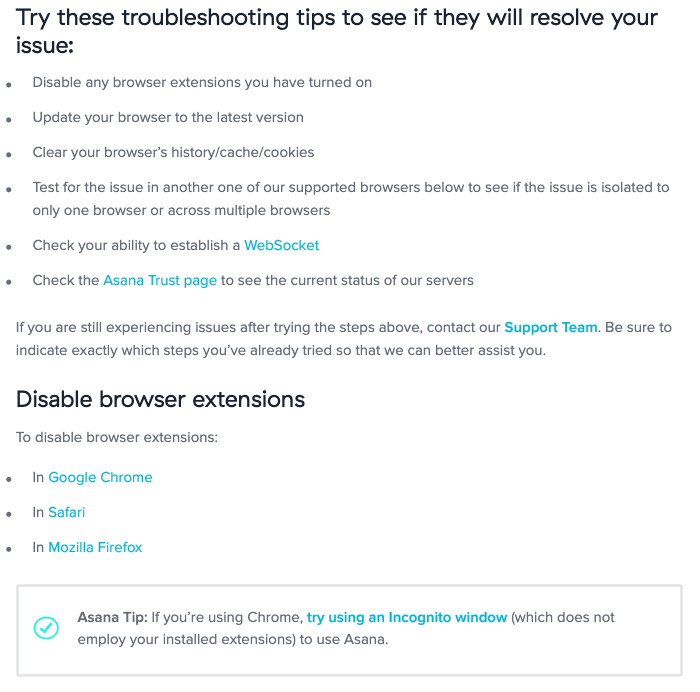
The article goes on to list a variety of potential solutions to the user’s connectivity issues, before breaking each one down with links to relevant resources.
Once again, the general structure of a troubleshooting article is simple: describe the problem, list potential solutions, and expand on each solution.
Troubleshooting article template
Title: [Problem name]
Problem: Brief description of the problem to be solved
Overview of possible solutions (if applicable)
Solutions:
- Solution 1
- Solution 2
- Solution 3
- Etc.
Outcome: Brief description of how to confirm the problem is solved and what to do if it isn’t
Further reading: Links to related articles
3. FAQ page
An FAQ page consists of a list of common questions about a particular customer service topic or product feature.
Some companies will use just a single, all-encompassing FAQ page, while others will have smaller FAQ pages for distinct product areas.
Usually, the questions are listed in a table of contents with anchor links that let readers jump to the answers lower down the page.
Here’s an example from Zappos3:
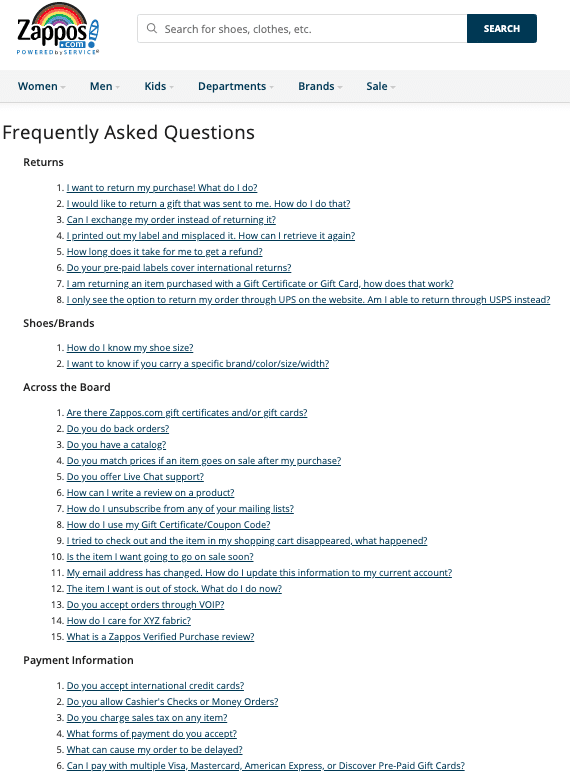
Here we see that Zappos lists the FAQs for all its topics on a single page. Questions are organized by category and are linked directly to their corresponding answers lower down the page.
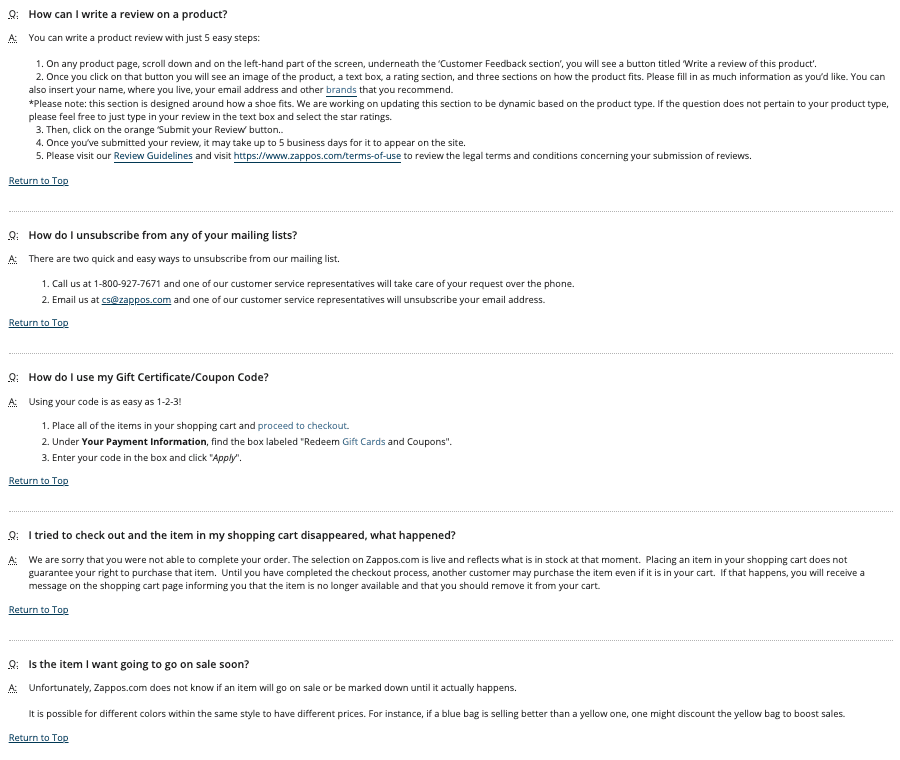
Notice that a “Return to Top” link sits beneath each answer. This makes navigation much easier given the length of the page.
FAQ template
Title: [Topic] Frequently Asked Questions
Topic (if applicable): Brief description of the topic being covered
Table of contents:
- Section 1
- Question 1
- Question 2
- Question 3
- Etc.
- Section 2
- Question 1
- Question 2
- Question 3
- Etc.
- Section 3
- Etc.
Answers:
- Section 1
- Question 1
- Answer 1
- Question 2
- Answer 2
- Question 3
- Answer 3
- Etc.
- Section 2
- Question 1
- Answer 1
- Question 2
- Answer 2
- Question 3
- Answer 3
- Etc.
- Section 3
- Etc.
Further reading: Links to related articles
Ready to create your next knowledge base article?
A knowledge base can transform your customer support for the better.
Customers enjoy the convenience and satisfaction of solving problems for themselves, and your support team spends less time fielding repeat questions and more time dealing with essential customer interactions.
But your knowledge base won’t fulfill this function if your articles aren’t up to scratch.
Support articles must be thoroughly planned, clearly written, and carefully reviewed to be of any use to customers.
Use the tips and templates covered in this post to take your knowledge base articles to the next level.
1 help.dropbox.com/files-folders/share/set-link-permissions2 asana.com/guide/help/faq/connectivity
3 zappos.com/general-questions
Originally published Jun 01, 2020, updated Sep 26, 2024




